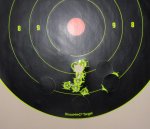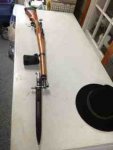Welcome to the world of "lawyers&liability". The extremely low number is so nobody can get in over their heads with the older rifles. Truth is the older rifles are built pretty damn good. Just that there is no one to sue if you blow it up.
I'm not a real fan of quickload as I've seen it give generally high loads with some very important factors left out. Condition or vintage of the rifle. A K-31 will hold a lot more pressure than what the book loads give. An 1889 won't hold much more. Too often the rifles get lumped together when in fact, although they are both 7.5x55, they are a different round. Your rifle will shoot GP-11. I suggest getting a box of that and chronoing your loads and work up accordingly.
As I mentioned before, the way the K-31 is made, and previous rifles dating back to the 1911, they don't like hot loads. They like moderate loads with moderate weight bullets. Work up for decent accuracy and stop there. Keep going up and you have more issues coming into play than poor accuracy. The straight pull action doesn't handle stiff loads well. Not because it isn't strong, but because you have no leverage removing a stiff case.
My suggestion is to gather several sources and find a safe place to start and work up from. Be very cognizant of your accuracy. These rifles are very accurate provided you do your part. I suggest 175 SMK's or something around that weight with a decent BC. The problem with trying to reproduce GP-11 is that nobody on this side of the pond makes bullets as good as those. You can reproduce velocities, but I can pretty much guarantee you that at long range your bullet is going to fall short. My load is 50 gr. of H4831SC for my K31. I don't think that will be a hot load in your Uncles' 1911. But work up to it.
I'll also have to say at this point, I don't know what 4032 is. I've never used it. I do know what 3032 is and 3031. It is very important you use the correct powder. Slight changes in numbers (and corresponding loads) can cause big problems. If you can't find readily available data for the powder you have I suggest getting a can of what there is available data for.
Thank you, Sandwarrior. I am aware of the "evolution" of the Schmidt-Rubin rifle. I also know exactly which one this particular one is. First, the rifle was developed in 1886, with updates in 1889, and 1911. The Karbine version of the 1911 (hence K-11), was not built until after the updated changes to the action. (There is another update which came in the 20's or early 30's, engendering the K-31) I checked the serial number on this one, and it was built in 1917.
I am running 168 SMK's for projectiles, and I have done the research on the loads with this powder. The 47gr load I mention is within the book specs in two manuals, as well as being relatively low pressure in QuickLoad. I have found QL to generally be conservative when I compare their max loads to the manuals in question.
I also did find a source for the data differences. The book manuals that I have are working off the data from the Swiss. The Swiss rated the max pressure at some 68,000psi, and work off of a 150% max pressure to working pressure max data. This yields approximately 45,000max working pressure. The rest of Europe uses a different standard, still based on the 68,000psi max pressure, but only a 125% max pressure to working pressure max, yielding a 54,000psi datum point. Thus, in a way, QuickLoad is correct, (using the European standard) and the manuals are also correct, using the Swiss standard.
Now, you say that the bolt is not friendly to hot loads, as, being a straight pull instead of a leveraged twist then pull, it is harder to open a slightly "sticky" chamber caused by higher pressures. I will definitely take that under advisement as I proceed.
I worked the test ladder loads off of the 47grain load I was working with. I have made loads---3each---in increments of 0.3 added grains, and then as I approach the targeted charge of 50.1, I did singles of 49.8 and on up at 0.1 grain increments. I have extra rounds for the two loads for 50.0, 50.1 (target charge) and 50.2. I thought in this manner, I could shoot one round of each charge weight, from lowest to highest, (using a different POA for each step) and stop when the pressure signs became noticeable. If all went well, I could reshoot the second and then third rounds at their respective POA's and check 3 shot groupings in this way. I will be approaching it slowly, so the only thing I can see going wrong is that I find the pressure signs early and have a bunch of bullets to pull---no really big deal, as I have the .308 collet for my puller.
Any one see a glaring deficiency in my plan?
Thanks again for the input.
Jbell, sorry, I don't mean to hijack your thread.....










